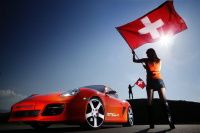VIRTUAL TRAININGS
 Visual imagination is when you have the desired picture in front of your eyes. For example, turning the turn of the fastest rider last season. A mental, reproducible image is when you scroll through a particular situation with all the details in your brain. For example, you mentally imagine how you yourself would drive a car, being in the place of the fastest rider on the track.
Visual imagination is when you have the desired picture in front of your eyes. For example, turning the turn of the fastest rider last season. A mental, reproducible image is when you scroll through a particular situation with all the details in your brain. For example, you mentally imagine how you yourself would drive a car, being in the place of the fastest rider on the track.
Yes, but for this you need to thoroughly know this track. To study the track will help a computer game. The fact is that the human brain is able, like a computer, to recreate the desired picture to the smallest details and this can and should be used in the training process.
Jacques Villeneuve – a famous fan of computer games told the following story. Before his first performance on the French track at Spa, he trained hard on the computer. The main thing, thoroughly, on a subconscious level, to learn an unfamiliar track, considered Villeneuve. And what? He took the pole in qualifying! Since then, none of the riders have already considered computer games empty toys. We will understand what the computer can really give. It is clear that the best for training is still suitable racing simulator (layout formula).
In terms of training mental imagination, he can give a lot. But we must understand that there are certain limitations. One visual row is not enough to create a mental image. The fact that the driver perceives reality, or in other words, receives information in three ways.
• First: visual or visual.
• Second: hearing.
• The third: sensual or sensory.
Training at the computer will help develop the first two paths, but not the third.
IMAGED RACING
A real racer should be able to drive as quickly as possible first mentally, and then go to the track. It is not joke. Sit comfortably at home or in a hotel in a chair, and your posture should copy your landing as much as possible in a racing car. Close your eyes and mentally imagine yourself driving your combat vehicle. Turn on the stopwatch (real, not imaginary) and go through your mental circle. If you know the track perfectly, the time of your imaginary circle will exactly coincide with the real time! Must match! You expect it and hope for it.
But expect and hope are dangerous words. For example, you say: “I hope to take part in races abroad.” There is no tactical or strategic attitude in your phrase. If you say otherwise: “My goal is to take part in races abroad,” it will be clear that you have a specific plan, and you know what needs to be done to implement it.
Imagine such a situation. You expect to show a certain result tomorrow in qualifying. Let it be a lap time – 1: 20.5. You leave and show 1: 20.8, then 1: 20.6, and finally 1: 20.5. It was possible to drive faster, but you completed your own installation. It would be possible to feel satisfaction, but since yesterday the track has changed for the better, and the other pilots were even faster. It had to be foreseen, expecting to show a specific time of the circle, setting itself a task. You hoped to show a certain time and showed it. Your expectation or hope has worked against you, being in practice a limiter or brake. The fact is that your expectations have become a real program of your mental imagination. Such a program really works effectively, often even too effectively. This is her danger! Conclusion: do not set yourself narrow tasks, for example, show a specific time. This can be a limiter, as in the example described above. Also, the “try to drive as fast as possible” installation will not work. What does the word “try” mean? The human brain does not perceive vague language. It is better to set a specific, understandable task, for example: “collect the best circle by sector”. It is clear that for this purpose it is necessary to concentrate as much as possible and to work out each sector of the route clearly.
Driving along the road in its virtual classification attempt, one should pay attention to the features of those or other corners of turns. Specific installations will be effective, for example: “sacrifice speed in the first turn of the three conjugates”. Then in the last corner you can start acceleration as early as possible and go straight with the maximum speed. Such specific tasks fit well into your mental program. Having fulfilled the passage of the route in imaginary attempts, most likely, the next day in reality you will not make mistakes. And the time of your best round will not be 1: 20.5, but 1: 20.3.
And one more very important aspect. If an error has occurred, you should never think about it. What has been done has already happened. Do not think about the past, there is nothing to change. Think of the future. To leave, as you would like to act in the moment! By focusing your attention on the present moment, you increase your chance to complete the task.


